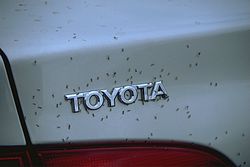- Midge
-
Midges 
A biting midge feeding on blood through an artificial membrane for insect rearing Scientific classification Kingdom: Animalia Phylum: Arthropoda Class: Insecta Order: Diptera Suborder: Nematocera Midges comprise many kinds of very small two-winged flies found world-wide. The term does not encapsulate a well-defined taxonomic group, but includes animals in several families of Nematoceran Diptera. While some midges are vectors for disease, many others play useful roles as prey items for insectivores, such as frogs. The habits of midges vary greatly among the component families, which include:[1]
- Blephariceridae, net-winged midges
- Cecidomyiidae, gall midges
- Ceratopogonidae, biting midges (also known as no-see-ums or punkies in North America)
- Chaoboridae, phantom midges
- Chironomidae, non-biting midges (also known as muffleheads in the Great Lakes region of North America)
- Deuterophlebiidae, mountain midges
- Dixidae, meniscus midges
- Scatopsidae, dung midges
- Thaumaleidae, solitary midges
Disease-spreading midges
The Ceratopogonidae (biting midges) include serious blood-sucking pests, feeding both on humans and other mammals. Some of them spread the livestock diseases Blue Tongue and African Horse Sickness – other species however are at least partly nectar feeders and some actually suck insect bodily fluids.[2]
Most other midge families are not bloodsuckers, but it is not possible to generalise rigidly because of the vagueness of the term "midge". There is for example no objective basis for excluding the Psychodidae from the list, and some of them (or midge-like taxa commonly included in the family, such as Phlebotomus) are blood-sucking pests and disease vectors.
Most midges, apart from the gall midges (Cecidomyiidae), are aquatic during the larval stage. Some Cecidomyiidae (e.g., the sorghum midge) are significant plant pests. The larvae of some Chironomidae contain haemoglobin and are sometimes referred to as bloodworms.[3]
See also
References
- ^ Merritt, R.W., and Cummins, K.W. (eds.), 1996. An Introduction to the Aquatic Insects of North America. Kendall/Hunt Publishing Company.
- ^ Alan Weaving; Mike Picker; Griffiths, Charles Llewellyn (2003). Field Guide to Insects of South Africa. New Holland Publishers, Ltd. ISBN 1-86872-713-0.
- ^ Walker, I. R. 2001. Midges: Chironomidae and related Diptera. pp. 43-66, In: J. P. Smol, H. J. B. Birks, and W. M. Last (eds). Tracking Environmental Change Using Lake Sediments. Volume 4. Zoological Indicators. Kluwer Academic Publishers, Dordrecht.

This article related to members of the insect order Diptera (true flies) is a stub. You can help Wikipedia by expanding it.

